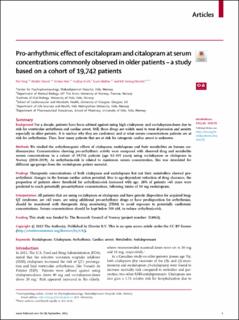| dc.description.abstract | Background For a decade, patients have been advised against using high citalopram- and escitalopram-doses due to risk for ventricular arrhythmia and cardiac arrest. Still, these drugs are widely used to treat depression and anxiety especially in older patients. It is unclear why they are cardiotoxic and at what serum concentrations patients are at risk for arrhythmias. Thus, how many patients that are at risk for iatrogenic cardiac arrest is unknown.
Methods We studied the arrhythmogenic effects of citalopram, escitalopram and their metabolites on human cardiomyocytes. Concentrations showing pro-arrhythmic activity were compared with observed drug and metabolite serum concentrations in a cohort of 19,742 patients (age 12–105 years) using escitalopram or citalopram in Norway (2010–2019). As arrhythmia-risk is related to maximum serum concentration, this was simulated for different age-groups from the escitalopram patient material.
Findings Therapeutic concentrations of both citalopram and escitalopram but not their metabolites showed pro-arrhythmic changes in the human cardiac action potential. Due to age-dependent reduction of drug clearance, the proportion of patients above threshold for arrhythmia-risk increased with age. 20% of patients >65 years were predicted to reach potentially pro-arrhythmic concentrations, following intake of 10 mg escitalopram.
Interpretation All patients that are using escitalopram or citalopram and have genetic disposition for acquired long-QT syndrome, are >65 years, are using additional pro-arrhythmic drugs or have predisposition for arrhythmias, should be monitored with therapeutic drug monitoring (TDM) to avoid exposure to potentially cardiotoxic concentrations. Serum concentrations should be kept below 100 nM, to reduce arrhythmia-risk. | en_US |

